Japan
Wood Products Prices
Dollar Exchange Rates of 25th
Aug
2022
Japan Yen 137.13
Reports From Japan
Consumer spending led growth
Japan¡¯s GDP grew at an annualised rate of 2.2% in the
second quarter of 2022 and that pulled the economy to
above what it was at the end of 2019 as consumer
spending rose and as covid restrictions on businesses were
ended. Consumer spending, which accounts for more than
half of Japan¡¯s economic output, led the growth as did
capital expenditure.
Economists expect the Bank of Japan to maintain its
current easing policy and the government to continue
providing support for households hit by both the pandemic
and more recently by surging prices. After taking account
of inflation, worker spending power has been falling for
three consecutive months.
The Norinchukin Research Institute has said it anticipates
growth will continue in the third quarter but that the pace
may slow as inflation takes a toll on disposable incomes.
The way ahead remains uncertain as slowing global
growth, rising inflation, supply chain constraints, a
weakening yen and the recent surge in covis infections
present multiple challenges.
See:
https://www.japantimes.co.jp/news/2022/08/15/business/economy-business/japan-economy-recovery/
Despite the good news most experts remain cautious about
the future. Consumer prices are rising driven by higher
commodity prices. Recently oil prices have begun to
decline but consumers are yet to benefit from this. A
government survey showed that most people expect prices
will remain high or increase.
This consumer pessimism stems from the jump in prices of
energy and food. Electricity prices are up almost 20%
from a year ago as is the cost of gas and low income
families are seriously affected.
Reiko Sakurai, NHK Senior Economic Commentator,
writes ¡°For the past 20 years, Japan has neglected to
prepare for the future. It has invested far less than other
G7 countries in corporate capital expenditure, public- and
private-sector research and development and human
resource development. The result is weak potential for
economic growth, which is why the latest GDP numbers
might not be quite the harbinger of recovery that they
appear¡±.
See:
https://www3.nhk.or.jp/nhkworld/en/news/backstories/2079/
Tax incentives for private forest owners
In 2023 Japan¡¯s Ministry of Environment will offer tax
incentives for private forest owners if they are recognised
as contributing to biodiversity conservation. The
incentives will include real estate acquisition and property
tax reductions for forests where habitats for rare plants and
animals remain conserved. Details of the plan are to be
decided.
At their summit in June 2021 leaders of the G7 including
Japan set a goal of protecting at least 30% of their
countries' land and oceans as healthy ecosystems by 2030.
Currently, the government designates 20.5% of Japan's
land area and 13.3% of its sea area as natural preservation
zones. Since this will not be enough private sector nature
conservation will be encouraged and rewarded.
See:
https://www.japantimes.co.jp/news/2022/08/24/business/privatesector-satoyama-forest-conservation/
Covid travel rules eased further
Japan will enact a series of reduced COVID-19 measures
starting 7 September that will make it easier for people to
enter the country. The government will scrap the need for
a negative COVID test prior to arrival (for all travelers
with at least three vaccine shots) and will increase the cap
on daily visitors to the country. At present, travelers to
Japan must present to airlines a negative Covid PCR test
taken within 72 hours of departure for Japan which has
been called a ¡°major hindrance¡± for both international
visitors and Japanese citizens.
See:
https://www.travelagentcentral.com/asia/japan-ease-entryrequirements-september-7
Japan pledges US$30 billion for Adrican Development
The Eighth Tokyo International Conference on African
Development (TICAD8) held in Tunisia concluded
recently. Japan pledged US$30 bil. in aid for development
in Africa saying it wants to work more closely with
African countries at a time when the rules-based
international order is under threat after Russia¡¯s invasion
of Ukraine.
See:https://www.mofa.go.jp/afr/af2/page1e_000469.html
A report on the TICAD8 Joint Press Conference can be seen at:
https://japan.kantei.go.jp/101_kishida/statement/202208/_00024.html
Yen likely to dip further
The divergence between Japanese and U.S. bond yields
has pushed the yen down 15% so far this year and it may
be the yen is heading for its biggest fall against the dollar
since 2013 and third steepest since the era of free-floating
exchange rates began in the early 1970s.
At the end of August the yen was trading around 137 per
dollar and speculation is that uncurbed inflation could
push it closer to a 24 year low of yen 140 per dollar.
See:https://www.asahi.com/ajw/articles/14698540
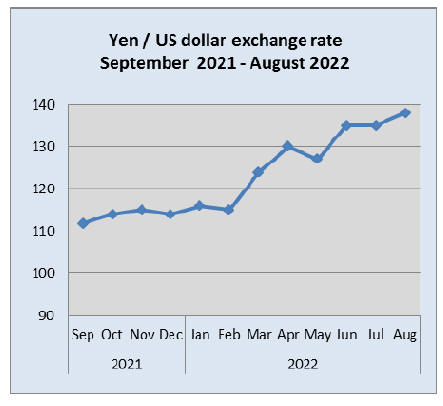
Housing starts in July came in 6% below those of
July
2021 and were slightly below the 75,000 starts in June.
July is not the main holiday period in Japan and it is likely
that August starts will be below the July level.
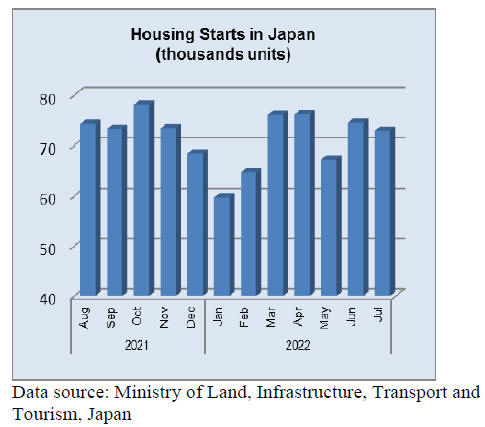
Up-tick in consumer confidence
The consumer confidence index rose slightly in August
which was a welcome change after the continual drop
since the beginning of this year. Households expect prices
to rise in the next 12 months which could sugnal a further
drop in consumption which has been observed in other
countries.
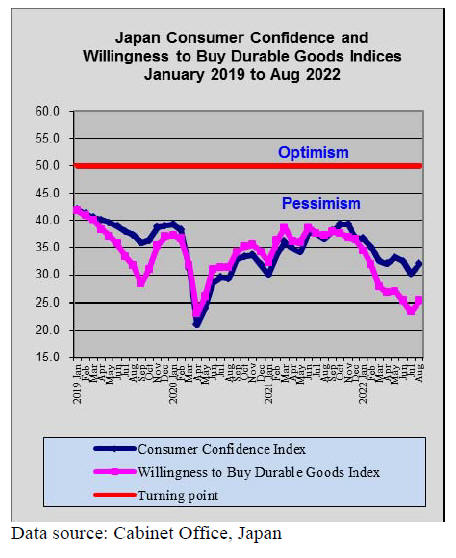
Import update
Assembled wooden flooring imports
The steep rise in the value of assembled wooden flooring
imports (HS441871-79) in June this year can be partly
explained by the depreciation of the yen which, in June,
was down around 7% against the US dollar. But the
exchange rate effect cannot explain the 65% year on year
rise in the value of imports.
The May surge in the value of imports brought the
monthly value back to the average for the preceeding
months.
Of total assembled flooring imports China was the
main
supplier in June accounting for around 55% of all
HS441871-79 imports. HS441875 is the main category of
flooring imports accounting for just over 50% of the total
but within this category most in June was shipped from
Austria, France and Vietnam. Shipments of HS441875
from China were well below those seen earlier in the year.

Plywood imports
June imports of plywood stood at 171,465 cu.m up 17%
year on year but down 6% from the previous month.
Indonesia and Malaysia are the main suppliers of plywood
to Japan and together they accounted for close to 70% of
Japan¡¯s June imports. Plywood imports from China have
been steadily rising since the start of the second quarter
and at almost 38,000 cu.m June imports accounted for
over 20% of total plywood imports. Shippers of plywood
in Vietnam also did well in June seeing an almost 40%
increase in shipment.
June shipments from Indonesia fell just over 20% month
on month in June and shipments from Malaysia were
down slightly in June and well below the average for the
year so far.
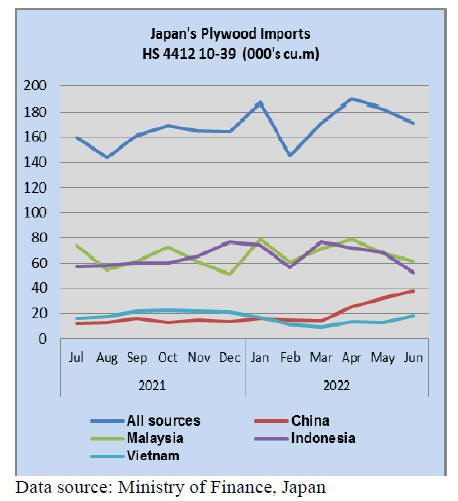
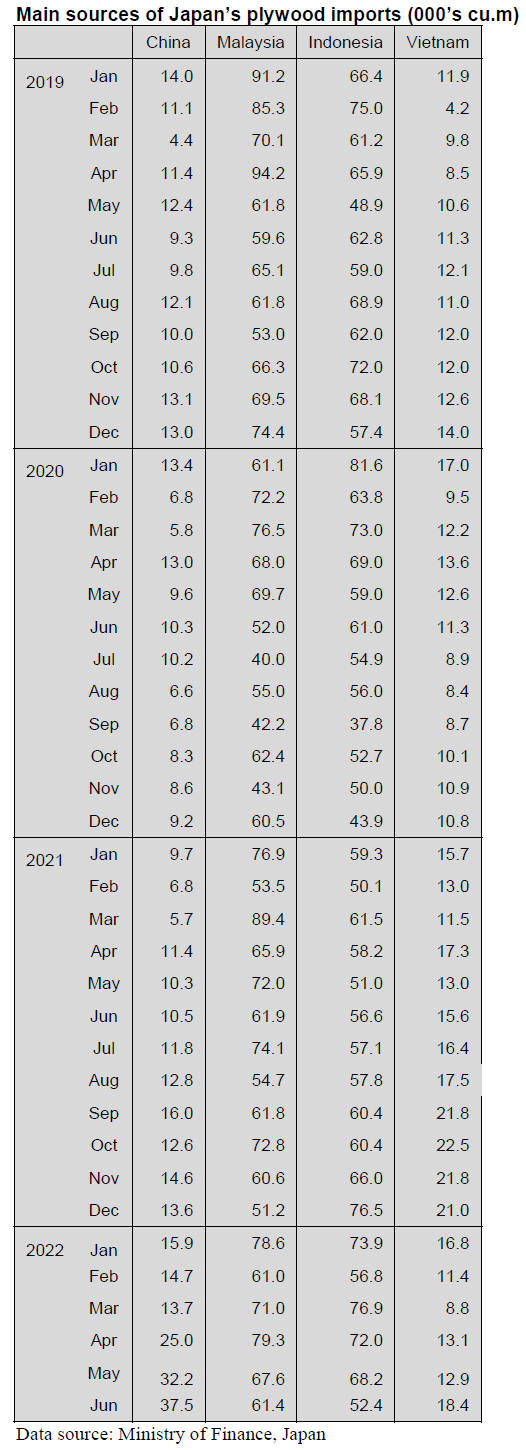
Trade news from the Japan Lumber Reports (JLR)
The Japan Lumber Reports (JLR), a subscription trade
journal published every two weeks in English, is
generously allowing the ITTO Tropical Timber Market
Report to reproduce news on the Japanese market
precisely as it appears in the JLR.
For the JLR report please see:
https://jfpj.jp/japan_lumber_reports/
Log export to China
Export of cedar logs for China is sluggish even though the
lockdown in China was lifted in June. An export volume
in May is 69,592 cbms, 47.3% less than the same month in
2021. This is for the first time with low level since last
August. Some reasons are a business downturn and a weak
real estate market in China.
Over 200,000 cbms of cedar logs were stocked around
Shanghai when the lockdown was lifted then the inventory
at ports dropped down around 160,000 cbms. However, a
shipment from plants and ports is slow and demand from
Chinese importers is inactive.
The present selling prices are around US$140, C&F per
cbm and it is about US$20 lower than the prices in last
spring. The purchase price of logs for exporters is 9,500
yen at ports per cbm and it is 1,500 yen lower than the
peak prices. The prices of ocean freights decreased from
US$140,000 per ship to US$100,000 ¨C 110,000. A weak
yen also makes the selling prices decreasing. Weak yen
helps exporters¡¯ profitability despite drop of dollar export
prices.
It has been four years since the U.S.A. imposed a duty on
logs to China. If the 25% sanction duty decreases, demand
for cedar fences for the U.S. market would be back.
Recently, people have an attention on the prices of NZ
logs. The prices are around US$145, C&F per cbm. It is
difficult to lower the export prices of cedar logs now
because there will be no profit so New Zealand radiate
pine log export prices are concern to Japanese cedar
exporters.
Domestic cedar logs markets are good. Inventory at plants
for lumber and plywood is enough. However, there are not
enough inventory for wooden biomass and the prices are
8,500 yen, delivered a tonne. As long as biomass wood
prices stay up high, it is difficult to reduce cedar log
export prices. Demand in China is less than supply.
Plywood
There is still a shortage of domestic softwood plywood.
The reasons are that demand decreased and Chinese
softwood plywood was imported in May and June with a
volume of 19,000 cbms. However, Japanese plywood
companies¡¯ shipment are very good. The inventory at the
end of June was 92,200 cbms. Shipment base is 0.3 month.
The prices of 3 x 6 and 12mm thickness of plywood are
holding at 2,000 yen, delivered per sheet.
The prices of South Sea plywood are still high. Since it
will be in rainy season in South Asia when new contracts
are produced, there are not much new orders and product
will be started after October. 3 x 6 JAS plywood panel for
concrete forming from costs US$850, C&F per cbm and
the yen cost will be higher in Japan due to a weak yen.
A movement of imported South Sea plywood is sluggish.
This is an unusual situation in this season. Usually, the
sluggish movement occurs at the end of July through
August but it has been slow since the beginning of this
year.
Future prices of JAS 3 x 6 plywood panel for concrete
forming are 2,450 yen, FOB per sheet and this is 50 yen
higher than last month. The prices in Japan are 2,300 yen,
delivered per sheet and this is also 50 yen higher than last
month.
South Sea log and products
The prices of South Sea lumber and Chinese lumber are
skyrocketing due to the high- priced lumber in South Asia
and a weak yen. The prices of Merkusii pine lumber in
Indonesia are US$950, C&F per cbm and of red pine
lumber in China are US$1,020 ¨C 1,050, C&F per cbm.
It is a good season to cut down Merkusii pine in Indonesia
and Indonesian companies are willing to produce.
However, there are enough inventory in Japan so
negotiations for new contracts are rough going. Demand in
Japan is not lively. Indonesian Merkusii pine lumber in
Japan costs around 135,000 yen, delivered per cbm.
Chinese red pine lumber costs around 140,000 yen,
delivered per cbm. Both kinds of lumber are 2,000 yen
more than last month.
The movement of South Sea logs is slow even if there are
much demand of South Sea lumber for steelmakers and
ship building companies and there are not enough demand
for producing trucks. A reason is a lack of semiconductor
supply.
|